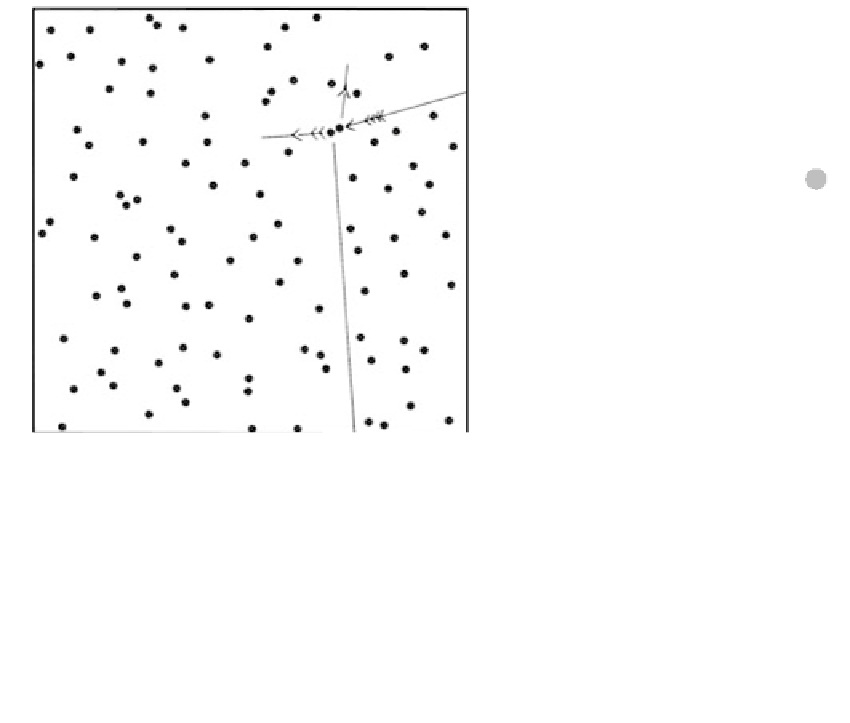Geoscience Reference
In-Depth Information
(a)
(b)
(c)
Fig. 2.2
Gas molecules collide. In 1883 Kelvin drew this conceptual
diagram of colliding gas molecules to scale. The molecules are repre-
sented in an area 1
Fig. 2.3
The increasing packing and regularity of molecules in solids,
liquids, and gases. (a) molecules in Gaseous 20 Å cubic volume; (b)
molecules in a Liquid 20 Å
2
and one molecule thick. By this time, Avagadro's
number was reliably known and the diameter of atoms was calculated
to be of order 10
7
mm or 10
4
20 Å
3 Å volume; (c) molecules in
. Atoms were suspected from the
evidence of the Brownian motion of tiny clay flakes (not pollen grains
as widely stated) floating in water, the moving molecules colliding with
the clays and imparting momentum. But it was not until 1906, when
Einstein developed a theory of molecular collisions to explain the
motions and the nature of
diffusion
, that the atomic theory was
universally accepted. Kinetic theory (Section 4.18) tells us that
molecules have speeds of order 10
2
a Solid 20 Å
20 Å
3 Å volume.
boundaries that interlock at certain angles to form
the whole aggregate. Under normal conditions solid
molecules undergo no net translational motions, but move
rapidly
in situ
by oscillation about some mean position.
Solid molecules thus have high potential energies and the
sensitive temperature control of oscillation frequency
means they can be good heat conductors. Metals may be
regarded as solid lattices of ions permeated by an electron
“gas.” The higher thermal conductivity of metals com-
pared to other crystalline solids like silicates and chlorides
is explained by the extreme mobility of these electrons that
carry heat energy, along with their intrinsic electrical
energy, with them.
10
3
ms
1
. An air molecule at
standard temperature and pressure has a mean speed of 470 ms
1
.
together, though the pattern is generally disordered
(Fig. 2.3) and unsteady, with the individual molecules still
moving randomly at the same high speeds as in gases but
with motion also in the form of oscillations and trans-
mitted vibrations. The closeness of neighboring molec-
ules explains the increased density and the difficulty of
compression. The vibrational and oscillatory molecular
motions explain the greater thermal conductivity and
specific heat compared to gases. Liquid molecules are close
enough to have large potential energies.
2.1.4
Earth's complex substances
Many of Earth substances are mixtures:
1
Earth's atmosphere is a mixture of gases. Despite gases
being good insulators and poor heat carriers, efficient heat
transport is due to ease of bulk movement and heat release
during changes of state.
2
Rock is a mixture of different crystalline, rarely glassy,
solids, each component having certain distinctive material
properties, melting points, and chemical composition.
3
Sediment avalanches are aggregates of solids but their
flow behavior resembles both fluids and gases, with frequent
granular collisions. Such aggregates are termed
granular
fluids
.
2.1.3
Solids
In solids the molecules or ions are very closely packed and
thus generally rigid (Fig. 2.3). Solid and liquid phases of
the same substance (e.g. ice and water) have similar den-
sities and compressibilities, emphasizing the close packing
of molecules in each state. X-rays reveal that many solids
with clear melting points form crystalline aggregates with
almost regular internal frameworks or lattices if formed
slowly from the liquid state. These crystals have planar




































Search WWH ::

Custom Search